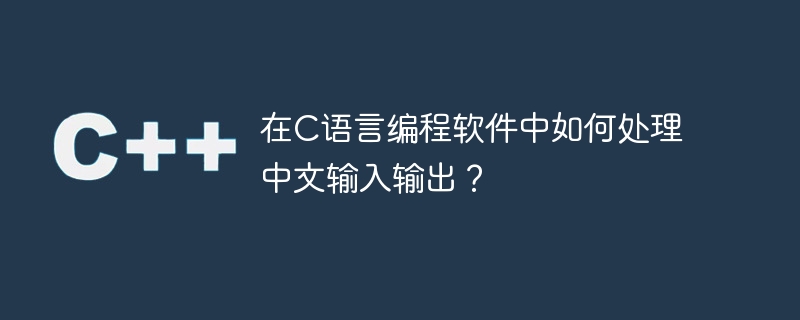

How to handle Chinese input and output in C language programming software?
With the further development of globalization, the application scope of Chinese is becoming more and more extensive. In C language programming, if you need to process Chinese input and output, you need to consider the encoding of Chinese characters and related processing methods. This article will introduce some common methods for processing Chinese input and output in C language programming software.
First of all, we need to understand how Chinese characters are encoded. In computers, the most commonly used Chinese character encoding method is Unicode encoding. Unicode encoding can represent almost all characters in the world, including Chinese characters. Unicode encoding uses multiple bytes to represent a character, and the specific encoding methods include UTF-8, UTF-16, and UTF-32.
In C language programming, in order to process Chinese characters, we need to ensure that the compilation environment supports unicode encoding. Most modern compilers and operating systems already support Unicode encoding. Once we ensure the support of the compilation environment, we can use the wide character type (wchar_t) to process Chinese characters.
For Chinese input, we can use the wscanf function to read wide character input. The wscanf function can use a format string to specify the input format like other input functions. For example, the following code demonstrates how to use the wscanf function to read Chinese input and output:
#include <stdio.h>
#include <wchar.h>
int main() {
wchar_t name[50];
wprintf(L"请输入您的姓名:");
wscanf(L"%ls", name);
wprintf(L"您好,%ls!
", name);
return 0;
}In the above code, we use %ls as the format string of wscanf, which means reading a wide character string. Similarly, we can also use the wprintf function to output Chinese characters. It should be noted that when outputting Chinese characters, you need to add the L prefix in front of the string.
In addition to using wide character types to process Chinese input and output, we can also use some other libraries to process Chinese characters. For example, the open source ICU (International Components for Unicode) library provides many functions for processing Unicode characters and can be used as a tool library for processing Chinese input and output.
When using the ICU library, we need to use the icu header file and link to the ICU library. The following is a sample code that uses the ICU library to process Chinese input and output:
#include <stdio.h>
#include <unicode/ustdio.h>
#include <unicode/ustring.h>
int main() {
UChar name[50];
u_printf(u"请输入您的姓名:");
u_scanf(u"%ls", name);
u_printf(u"您好,%ls!
", name);
return 0;
}In the above code, we use the UChar type to represent Unicode characters, and use the u_printf and u_scanf functions for Chinese input and output.
It should be noted that when processing Chinese input and output, whether you use wide character types or other libraries, you need to ensure the consistency of the encoding method. For example, if the input uses UTF-8 encoding, then you need to convert it to the corresponding encoding when processing Chinese characters.
In short, when processing Chinese input and output in C language programming, you need to consider the encoding of Chinese characters and the corresponding processing methods. Using wide character types or other libraries to handle Chinese input and output is a common approach. I hope this article will be helpful to the method of processing Chinese input and output in C language programming software.
The above is the detailed content of How to implement Chinese input and output in C language program?. For more information, please follow other related articles on the PHP Chinese website!




